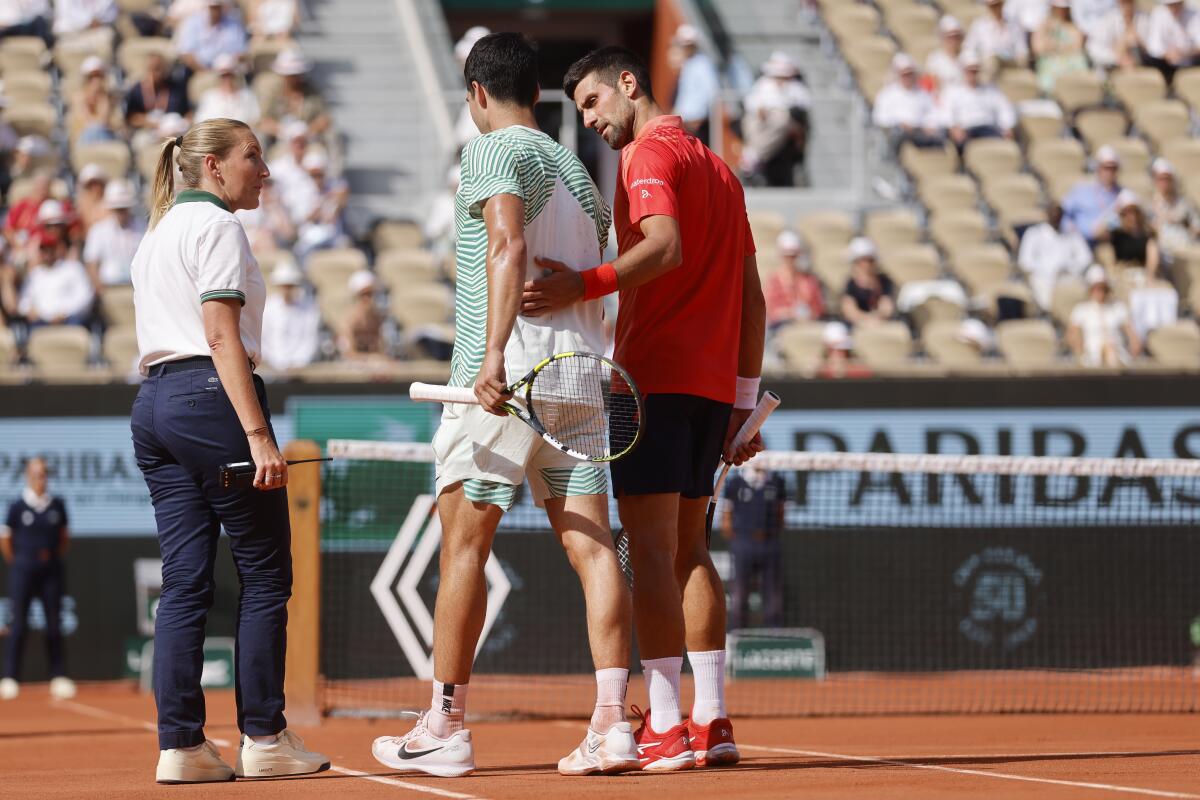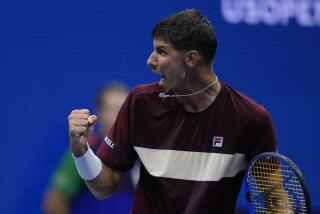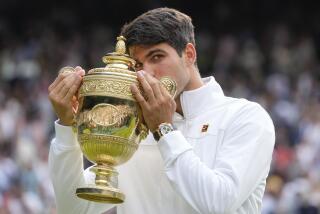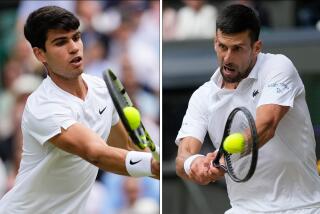French Open: Carlos Alcaraz shines before cramps help Novak Djokovic win semifinal

PARIS — Novak Djokovic used every bit of his experience, relentlessness and fitness to beat a cramping Carlos Alcaraz 6-3, 5-7, 6-1, 6-1 at the French Open on Friday and move one win away from a record 23rd Grand Slam title.
The No. 1-ranked Alcaraz produced one particularly brilliant shot — one that went viral within minutes and could be talked about for years — en route to claiming the second set of what, at the time, was a closely contested and thrilling showdown.
But in the end, this highly anticipated matchup was as anticlimatic as can be.
That’s because early in the third set, after nearly 2½ hours of exertion and tension in 85-degree heat at Court Philippe Chatrier, Alcaraz’s body began to lock up. First, his hand began to cramp. Then his legs. And so, at 1-all, Alcaraz needed to take a break and get treated by a trainer. Because it was not a changeover, Alcaraz was required to forfeit the following game and fell behind 2-1.
From there, it was pretty much all over. Djokovic, who is 36, was able to cruise to the finish against Alcaraz, who is 20, making for the widest age gap in a men’s Grand Slam semifinal since 1991.
Score one for the old guys.
It was the 45th Grand Slam semifinal for Djokovic and the second for Alcaraz.
“I feel for him. I feel sorry. ... I hope he can recover very soon,” Djokovic said. “I told him at the net he knows how young he is. He has plenty of time ahead of him. He’s going to win this tournament, I’m sure, many, many times. He’s an unbelievable player.”
Not this time.
Instead, it is No. 3 Djokovic who will meet No. 4 Casper Ruud of Norway or No. 22 Alexander Zverev of Germany in Sunday’s final.
Ruud — a two-time major runner-up last year, including in Paris — and Zverev — the runner-up at the 2020 U.S. Open — were scheduled to play the second semifinal later Friday. Neither owns a major trophy.
Djokovic is hoping to leave Roland Garros this year with his third French Open title and his 23rd Slam championship overall, which would break a tie with rival Rafael Nadal for the most by a man in the history of tennis.
Nadal was absent from his favorite tournament this year because of a hip injury.
That left most people focusing on two men over the past two weeks: Djokovic, who has won 10 of the past 19 majors, and Alcaraz, who won the U.S. Open in September. Djokovic is one of the dominant figures in the sport’s history; Alcaraz is considered its future.
And they sure put on a show for two sets.
“I think we were both at the physical limit, to be honest, toward the end of the second set,” said Djokovic, who had his right forearm massaged by a trainer during that set. ”I wasn’t feeling fresh at all. We went toe-to-toe.”
Djokovic was at his stretching, sliding best, whipping groundstrokes that pushed Alcaraz all over the place.
Alcaraz, somehow, chased just about everything down, his speed and instinct as good as there is.
Nothing was as spectacular as THAT shot by Alcaraz. The shot of the day, of the tournament, of the year.
It arrived at 1-all in the second set. Having lured Alcaraz forward, Djokovic sent the ball toward the baseline. Many a player would have given up on the point and chosen to move onto the next. Or perhaps attempted to get there but failed. Alcaraz gave chase, running with his back to the net, then sliding beyond the baseline, his left foot bending as he came to a halt and spun his body around and out of the way, leaning backward in order to lace a forehand past Djokovic for a winner.
As the crowd roared and rose for an ovation to celebrate the feat, Alcaraz raised his left hand and briefly jutted his index finger into the “No. 1 gesture.”
He smiled a wide smile.
Even Djokovic had to smile, and used his racket to applaud.
Everything changed in the third set, though.
Right before missing a forehand return to make it 1-all, Alcaraz flexed his hand. It was clearly bothering him. After that forehand, he hopped on his left leg, then clutched his right calf. He dropped his racket on the ground. Chair umpire Aurélie Tourte went over to check on him. So did Djokovic, walking all the way to Alcaraz’s side of the court.
A medical timeout for an injury — what the rulebook calls “an acute medical condition” — during a match is allowed. But treatment for cramps when it isn’t time for a changeover is not permitted without penalty. So Tourte told Alcaraz that he could sit on the sideline and get help from a trainer, but he would need to concede the following game, which he did.
When the scoreboard was updated without a point being played, reflecting that Djokovic now led 2-1 in that set, the crowd jeered and whistled and booed, until Tourte explained in French what was happening.
“From that moment onwards,” Djokovic said, “it was a different match.”
Alcaraz would only claim one more game. It is Djokovic who gets to keep playing.
More to Read
Go beyond the scoreboard
Get the latest on L.A.'s teams in the daily Sports Report newsletter.
You may occasionally receive promotional content from the Los Angeles Times.










